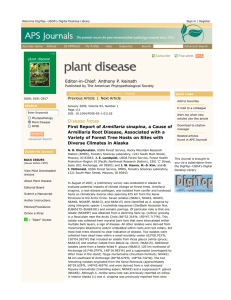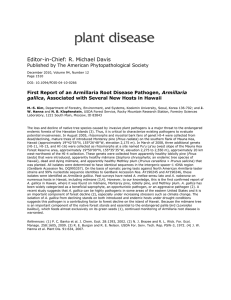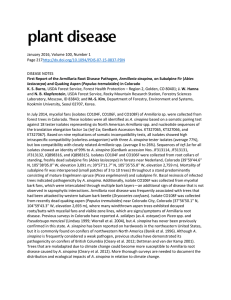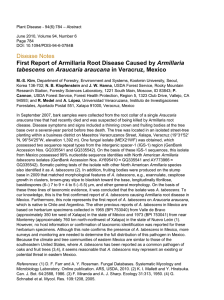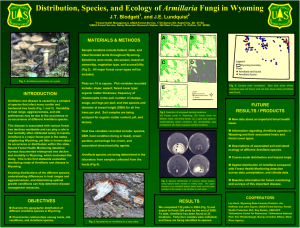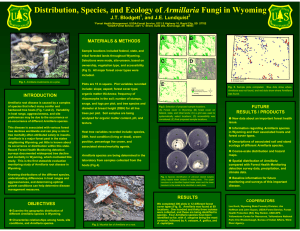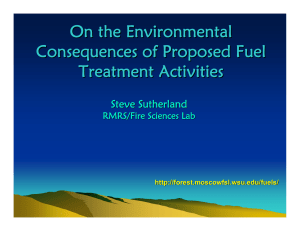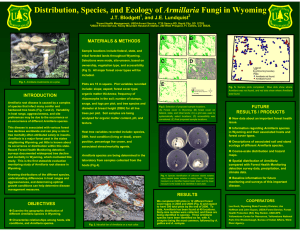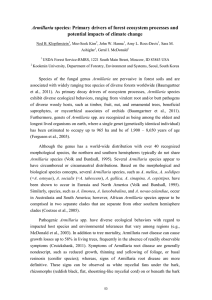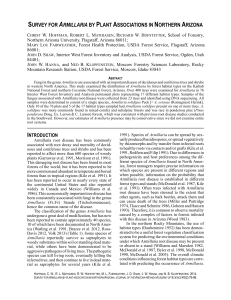Document 12019132
advertisement
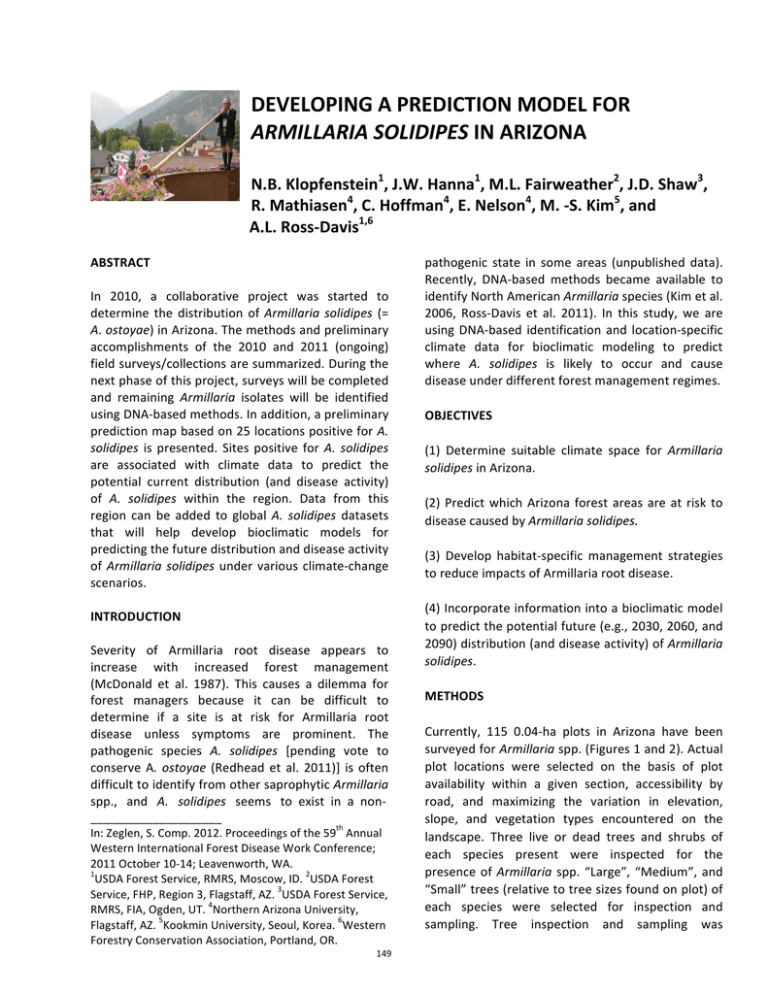
DEVELOPING A PREDICTION MODEL FOR ARMILLARIA SOLIDIPES IN ARIZONA N.B. Klopfenstein1, J.W. Hanna1, M.L. Fairweather2, J.D. Shaw3, R. Mathiasen4, C. Hoffman4, E. Nelson4, M. -­‐S. Kim5, and A.L. Ross-­‐Davis1,6 ABSTRACT In 2010, a collaborative project was started to determine the distribution of Armillaria solidipes (= A. ostoyae) in Arizona. The methods and preliminary accomplishments of the 2010 and 2011 (ongoing) field surveys/collections are summarized. During the next phase of this project, surveys will be completed and remaining Armillaria isolates will be identified using DNA-­‐based methods. In addition, a preliminary prediction map based on 25 locations positive for A. solidipes is presented. Sites positive for A. solidipes are associated with climate data to predict the potential current distribution (and disease activity) of A. solidipes within the region. Data from this region can be added to global A. solidipes datasets that will help develop bioclimatic models for predicting the future distribution and disease activity of Armillaria solidipes under various climate-­‐change scenarios. INTRODUCTION Severity of Armillaria root disease appears to increase with increased forest management (McDonald et al. 1987). This causes a dilemma for forest managers because it can be difficult to determine if a site is at risk for Armillaria root disease unless symptoms are prominent. The pathogenic species A. solidipes [pending vote to conserve A. ostoyae (Redhead et al. 2011)] is often difficult to identify from other saprophytic Armillaria spp., and A. solidipes seems to exist in a non-­‐ _____________________ th In: Zeglen, S. Comp. 2012. Proceedings of the 59 Annual Western International Forest Disease Work Conference; 2011 October 10-­‐14; Leavenworth, WA. 1 2 USDA Forest Service, RMRS, Moscow, ID. USDA Forest 3 Service, FHP, Region 3, Flagstaff, AZ. USDA Forest Service, 4 RMRS, FIA, Ogden, UT. Northern Arizona University, 5 6 Flagstaff, AZ. Kookmin University, Seoul, Korea. Western Forestry Conservation Association, Portland, OR. 149 pathogenic state in some areas (unpublished data). Recently, DNA-­‐based methods became available to identify North American Armillaria species (Kim et al. 2006, Ross-­‐Davis et al. 2011). In this study, we are using DNA-­‐based identification and location-­‐specific climate data for bioclimatic modeling to predict where A. solidipes is likely to occur and cause disease under different forest management regimes. OBJECTIVES (1) Determine suitable climate space for Armillaria solidipes in Arizona. (2) Predict which Arizona forest areas are at risk to disease caused by Armillaria solidipes. (3) Develop habitat-­‐specific management strategies to reduce impacts of Armillaria root disease. (4) Incorporate information into a bioclimatic model to predict the potential future (e.g., 2030, 2060, and 2090) distribution (and disease activity) of Armillaria solidipes. METHODS Currently, 115 0.04-­‐ha plots in Arizona have been surveyed for Armillaria spp. (Figures 1 and 2). Actual plot locations were selected on the basis of plot availability within a given section, accessibility by road, and maximizing the variation in elevation, slope, and vegetation types encountered on the landscape. Three live or dead trees and shrubs of each species present were inspected for the presence of Armillaria spp. “Large”, “Medium”, and “Small” trees (relative to tree sizes found on plot) of each species were selected for inspection and sampling. Tree inspection and sampling was conducted by excavating at least one main root and the nearest portion of root collar to a radial distance of approximately 0.5 m from the bole. Shrubs were sampled by extracting the root system. If present, rhizomorphs were collected from trees and shrubs. If resinosis or other symptoms of disease were apparent, the root collar was cut to inspect and collect bark-­‐fan samples, if present. Armillaria samples were kept cool and mailed to the Forestry Sciences Laboratory in Moscow, where isolates were established in culture in preparation for DNA-­‐based species identification. Figure 1: Field crew establishing a plot (left); Tree showing possible symptoms of Armillaria root disease (center); Armillaria spp. basidiocarps at the base of a tree (right). Figure 2: Map of Arizona showing collection sites during the 2010 and 2011 field seasons (left); Preliminary example of predicted suitable climate space for Armillaria solidipes in Arizona based on 25 locations positive for A. solidipes collected in 2010. Dark green represents predicted suitable climate space for A. solidipes with light green, yellow, orange, and red indicating increased likelihood of suitable climate space, respectively (right). 150 PROJECT OVERVIEW FUTURE WORK We will continue to conduct DNA-­‐based identification of Armillaria species at the RMRS Forestry Sciences Lab in Moscow, ID. After all Armillaria isolates are identified, locations confirmed to have A. solidipes will be used to predict suitable climate spaces for this pathogen (Figure 2). This 151 climate window can also be used to examine how various climate-­‐change scenarios may affect A. solidipes in Arizona. The methods developed from this project can also be used to model other important forest pathogens and examine the potential for invasive species to occupy new areas under a changing climate. ACKNOWLEDGEMENTS This project was partially funded by the Forest Health Protection, Special Technology Development Program (R6-­‐2010-­‐02: Developing and applying methods to predict present and future climatic influences on Armillaria root disease), USDA Forest Service, RMRS, Interior West Region Forest Inventory and Analysis, Joint Venture Agreement (07-­‐JV-­‐11221662-­‐285), and Mission Research Program, School of Forestry, Northern Arizona University, Flagstaff, AZ. REFERENCES Kim, M.-­‐S., Klopfenstein, N.B., Hanna, J.W., McDonald, G.I. 2006. Characterization of North American Armillaria species: Genetic relationships determined by ribosomal DNA sequences and AFLP markers. Forest Pathology. 36:145-­‐164. McDonald, G.I., Martin, N.E., Harvey, A.E. 1987. Armillaria in the northern Rockies: Pathology and host susceptibility on pristine and disturbed sites. USDA Forest Service, Research Note INT-­‐371. Intermountain Research Station, Ogden, UT. 5 p. McDonald, G.I., Tanimoto, P.D., Rice, T.M., Hall, D.E., and others. 2005. Fuels planning: science synthesis and integration; environmental consequences fact sheet 13: Root Disease Analyzer-­‐Armillaria Response Tool (ART). USDA Forest Service, RMRS-­‐RN-­‐23-­‐ 13WWW. Rocky Mountain Research Station, Fort Collins, CO. 2 p. Redhead, S.A., Bérubé, J., Cleary, M.R., Holdenrieder, O., and others. (2033) Proposal to conserve Armillariella ostoyae (Armillaria ostoyae) against Agaricus obscurus, Agaricus occultans, and Armillaria solidipes (Basidiomycota). Taxon. 60(6):1770-­‐1771. Rehfeldt, G.E., Crookston, N.L., Warwell, M.V., Evans, J.S. 2006. Empirical Analyses of plant-­‐climate relationships for the western United States. International Jouranl of Plant Science. 167:1123-­‐ 1150. Ross-­‐Davis, A.L., Hanna, J.W., Kim, M.-­‐S., Klopfenstein, N.B. 2011. Advances toward DNA-­‐ based identification and phylogeny of North American Armillaria species using elongation factor-­‐ 1 alpha gene. Mycoscience. Published online first 8/13/11, DOI 10.1007/s10267-­‐011-­‐0148-­‐x. 152 Proceedings of the 59th Annual Western International Forest Disease Work Conference October 10-­‐14, 2011 Leavenworth, Washington Proceedings of the 59th Annual Western International Forest Disease Work Conference October 10th-­‐14th, 2011 Enzian Inn Leavenworth, Washington Compiled by: Stefan Zeglen BC Ministry of Forests, Lands and Natural Resource Operations, Nanaimo, BC and Patsy Palacios S.J. and Jessie E. Quinney Natural Resources Research Library College of Natural Resources Utah State University, Logan, UT ©2012, WIFDWC Papers are formatted and have minor editing for language, and style, but otherwise are printed as they were submitted. The authors are responsible for content.
